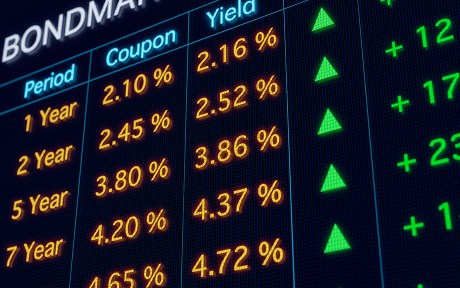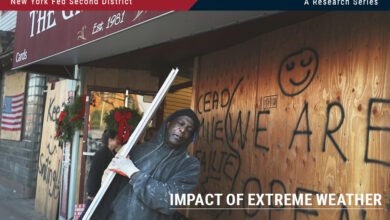Bond Funds in the Aftermath of SVB’s Collapse


March 2023 will rightfully be remembered as a period of major turmoil for the U.S. banking industry. In this post, we go beyond banks to analyze how fixed-income, open-end funds (bond funds) fared in the days after the start of the banking crisis. We find that bond funds experienced net outflows each day for almost three weeks after the run on Silicon Valley Bank (SVB), and that these outflows were experienced diffusely across the entire segment. Our preliminary evidence suggests that the outflows from bond funds may have been an unintended consequence of the exceptional measures taken to strengthen the balance sheet of banks during this time.
Bond Funds during the Bank Run of March 2023
The events of March 10, starting with the run on SVB’s deposits and ending with SVB’s failure and takeover by the FDIC, led to widespread turmoil in the banking industry. In response to the crisis, authorities acted swiftly by establishing the Bank Term Funding Program (BTFP) on Sunday, March 12, a measure that was designed to stave off further runs by bank depositors.
While much has been written about how banks weathered the crisis, here we assess how nonbanks were affected by the same events, focusing on the fast-growing segment of open-end bond funds. These vehicles offer agents the opportunity to invest in fixed-income instruments, such as corporate or government bonds, and a variety of more specialized instruments (for example, agency securities). Since investors can redeem their investments on demand, if the funds were to experience a wave of redemptions, they may need to sell a portion of their assets. But because bond funds invest in instruments of varying degrees of liquidity, these potential asset sales may lead to an overall loss in the value of their remaining balances. This institutional feature of open-end bond funds leaves them exposed to liquidity risk, similar in nature to the run risk faced by banking institutions (see, for instance, research by Chen et al. and Goldstein et al., as well as policy statements from the Financial Stability Board and the SEC).
The establishment of the BTFP may have led to unintended consequences for investors in bond funds. In particular, bank deposits suddenly became comparatively safer on Monday, March 13, after the facility started to function. Consequently, the value of the liquidity services provided by holdings in bond funds might have diminished relative to those provided by bank deposits, given the similarity between these two liquidity instruments. As markets resumed operation, fund investors may have had an additional incentive to redeem, thus, according to this conjecture, contributing to abnormally persistent outflows from the bond funds.
Did Bond Fund Outflows Increase after the Run on SVB?
Using daily flow data from Morningstar, we find that fixed income funds experienced persistent outflows every day after the weekend of SVB’s failure and continued for fourteen consecutive business days. In the chart below, we report net flows for a longer time series, to show that while aggregate outflows happen routinely in this industry, they are typically reversed quickly in the following days.
Fixed Income Funds Net Flows, Feb-Apr 2023
However, outflows persisting for almost three weeks is quite unusual. Using daily data from January 2018 to July 10, 2023, we count instances of outflows that persisted for consecutive days. The chart below shows that outflows typically persist up to three days, with anything longer occurring rarely.
Fixed Income Outflow Episodes by Duration
This spell of outflows was not just driven by a handful of very large funds, which were perhaps heavily exposed to the affected banks or held similar asset portfolios to those of the affected banks. Instead, the outflows affected a wide cross-section of bond funds: indeed, out of 1,587 fixed income funds in our dataset between March 13 and March 30, 2023, 1,128 (or about 71 percent) experienced cumulative net outflows.
Could these persistent bond fund outflows be driven not by the bank run but instead by a broad, economy-wide reaction to the banking crisis that pushed investors in investment funds to change their asset allocation? To address this alternative explanation, we compare the net flows of corporate bond funds and equity funds, since research studies have empirically documented that the “run-like” behavior typically associated with bond funds, and especially the corporate bond segment, is not found in equity funds. If fund investors withdrew in response to an economy-wide increase in risk and uncertainty after March 10, then we should observe a similar pattern of net outflows for both corporate bond and equity funds. However, if at least part of the post-SVB dynamics is driven by investors’ re-assessment of the run risk of their fund holdings, then we should observe differentially stronger outflows from corporate bond funds.
The chart below shows that equity and corporate bond funds exhibit a very similar pattern prior to the run on SVB. After the run, corporate bond funds did experience cumulatively more severe outflows, a pattern consistent with the greater perceived safety of bank deposits relative to bond holdings after the initiation of the BTFP.
Cumulative Net Flow as Share of Assets Under Management
The Effect of Interest Rates on Bond Fund Holdings
The banking crisis, and the subsequent government intervention, occurred during a period of rising interest rates (and in fact the bank deterioration itself was in large part driven by rising rates). The crisis led to a downward revision of market expectations regarding the path of interest rates. And because lower interest rates benefit fixed-income instruments, the negative impact on flows in bond funds might have been even stronger in the absence of this interest rate channel. We thus repeat the previous exercise, this time comparing outflows within the corporate bond funds segment, but between funds with differential exposures to interest rates. To do so, we consider the net flow trends of long and intermediate term, investment grade corporate bond funds, versus those of ultrashort and short term, investment grade corporate bond funds. The funds with the longer maturity structure should be more exposed to interest rate changes, so these funds should experience relatively less severe outflows than the funds with a very short maturity structure, if investors expect lower rates after the crisis. The differential effect should be a measure of the perceived higher run risk post BTFP. As expected, the chart below shows that, while both short-maturity and long-maturity funds experience increasing outflows since March 1, the shortest maturity funds experience a relatively greater acceleration in outflows after March 13.
Cumulative Net Flow as Share of Assets Under Management
Note: Series display cumulative net flows for short- and long-maturity funds.
To better quantify the effect, in the table below we compare the cumulative net flows as a percentage of assets under management (AUM) experienced by the two categories of funds in the days prior to March 10 (“Before”), and the days starting on March 13 (“After”). The “Delta” row shows the difference (After – Before), with the isolated number in the last column representing the difference in the differences (i.e., Delta Short – Delta Long). Hence, the hypothesized effect associated with the introduction of the BTFP is responsible for extra outflows in the order of about 0.5 percent of total AUM.
Cumulative Net Flows by Fund Type, Before and After SVB’s Collapse
| Long Funds | Short Funds | ||
| Before | 0.15% | -0.73% | |
| After | -0.31% | -1.69% | |
| Delta | -0.46% | -0.96% | -0.50% |
Was the outflow from bond funds after the failure of SVB severe enough to raise potential financial stability concerns? Probably not. In aggregate, the net bond fund outflow was about $15 billion, which is a tiny fraction of the overall bond fund market. However, even if minor in absolute terms, small-scale asset sales could still be sufficient to dislocate prices in illiquid markets, giving rise to potential channels of shock amplification. This is an issue for future research.
Final Words
Our analysis highlights how financial intermediation activities seem quite closely intertwined. Thus, banks and nonbank financial institutions should not be seen as separate “domains.” Accordingly, supervisors and regulators may wish to take a more integrated approach to monitoring and regulating financial intermediation activities—one that considers both direct effects and indirect consequences of shocks across a range of institution types.

Nicola Cetorelli is the head of Non-Bank Financial Institution Studies in the Federal Reserve Bank of New York’s Research and Statistics Group.

Sarah Zebar is a research analyst in the Federal Reserve Bank of New York’s Research and Statistics Group.
How to cite this post:
Nicola Cetorelli and Sarah Zebar, “Bond Funds in the Aftermath of SVB’s Collapse,” Federal Reserve Bank of New York Liberty Street Economics, November 28, 2023, https://libertystreeteconomics.newyorkfed.org/2023/11/bond-funds-in-the-aftermath-of-svbs-collapse/.
Disclaimer
The views expressed in this post are those of the author(s) and do not necessarily reflect the position of the Federal Reserve Bank of New York or the Federal Reserve System. Any errors or omissions are the responsibility of the author(s).





